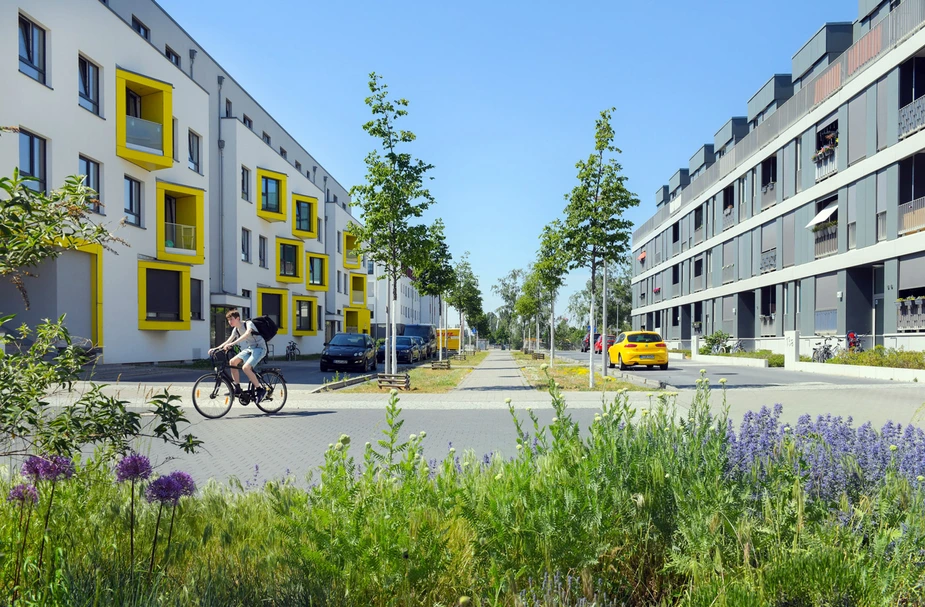A place of well-being
About the status quo of residential construction in Adlershof’s Science City and what else is planned
Sabrina Böttcher is the group leader of the Special Department Residential Construction-Project Management and Urban Land-Use Planning at the Senate Department for Urban Development and Housing. In the WISTA magazine Potenzial, she tells us about residential construction in the Johannisthal/Adlershof development area.
Potenzial: The Science City Adlershof underwent a remarkable development in the past few years. It has become a place with a high quality of life. How many flats have been built or occupied here and how many more are under construction or in the pipeline?
Sabrina Böttcher: Of the currently 5,500 residential units (RUs) that are planned as part of the Berlin-Johannisthal/Adlershof development measure, 2,500 have already been completed, 600 are under construction, and an additional 2,400 RUs are in planning. Some of the completed estates are “Living on the Landscaped Park” (“Wohnen am Landschaftspark“) with 386 detached houses, “Media Window” (“Medienfenster”) with 153 RUs, and “VivaCity Adlershof” with 136 RUs. In the “Living on Campus I” estate, which also includes the Student Village with 386 units, 1,166 RUs have been completed. An additional 505 RUs and 108 student apartments are being built by HOWOGE, a municipal housing association, on the adjacent “Living on Campus II” estate on Hermann-Dorner-Allee. In the “Johannisgärten” estate, HOWOGE has completed 314 RUs last year, many of which are already occupied. The project “Living on Eisenhutweg 54-76” is planning to build 585 RUs. The draft development plan for a new urban estate on Segelfliegerdamm, a mixed-use project with 1,800 flats on the premises of the former East German company “VEB Kühlautomat”, has been presented to the public in May. The Science City is now home to 4,300 people. The developers have created a good mixture, made up of municipal housing associations, cooperatives, private investors, construction groups, and individual home builders.
Who is the target audience for the planned flats?
Everybody is welcome in Adlershof. We are aiming for the so-called Berlin mixture of families, singles as well as elderly people and students. By the way, the proportion of subsidised flats, which was about six percent in “Living on Campus I”, rose to about 50 percent in “Living on Campus II”.
What sets apart the quality of living in Adlershof?
I can name three major aspects here. First, it’s the environmentally friendly way of construction and high energy standards. Things like green roofs, good rainwater drainage, photovoltaics, and the use of solar thermal energy. Examples of this are projects like “Powerhouses”, “Newtonprojekt”, or “Future Living”. Secondly, there are some instances of impressive state-of-the-art architecture like “Medienfenster”, with its distinctive structure and rhythmic recesses, or the “Tetris” house, which has duplex apartment locked into each other like a jigsaw puzzle. Thirdly, the availability of community areas like the ones at Adlershof’s Student Village is very modern and cost-efficient. Club rooms, gyms, gardens, and laundromats are also very popular.
What about the local infrastructure and social facilities?
The neighbourhood’s most visible asset is probably its direct access to the large 68-ha landscaped park with its playgrounds and sports fields. It has a number of other sports facilities as well as seven daycare facilities (three more are planned), two medical centres, and many other green areas and open spaces. Moreover, the number of cafés, bistros, and restaurants as well as shops is growing, and there’s the Adlershofer Tor mall. This range will continue to grow as more people move to Adlershof over time. We are also planning two new schools: preparation of construction of a Gemeinschaftsschule, a school that has children all ages under one roof, on Eisenhutweg/Hermann-Dorner-Allee is underway, while, on Gerhard-Sedlmayr-Strasse, a three-form primary school could be built if the demand holds up.
What are other location factors for tenants and owners?
This is the right place for people who don’t need and don’t want to live close to the city centre. It has good transport connections through public transport, the airport, and the motorway. In addition, living among a growing, modern technology site comes with a growing supply of jobs. There are ample recreational areas close-by. In addition to the landscaped park, nature and green areas are just a short distance away, for example, the cycle path along Teltow Canal, the Rudower Höhen, or Köllnische Heide. Not to mention the cultural opportunities of Köpenick and Alt-Adlershof, including theatres, concerts, or The Long Night of the Sciences.
How do you apply to one of these flats?
They are let out and sold by the owners on all common real estate portals. HOWOGE has a waiting list for those flats of the “Living on Campus II” project on Hermann-Dorner-Allee that are still under construction.
By Edith Döhring for Potenzial – The WISTA Magazine
